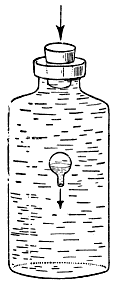
Up: Glassmaking

Gilbert: 11 of 65
|
|

| |

FIG. 14
THE BALLOON SINKS AND RISES
|
make a scratch with the file about ¼ inch from the bulb,
break the tube at this point (Fig. 13), and
smooth the rough edge.
Put the bulb in a tumbler of water. Does
it float? If not, make another balloon with a larger bulb.
Experiment 8. Magic.
Find a large bottle made of clear glass,
the neck of which will fit your solid rubber stopper.
Fill the bottle with water to overflowing,
insert the balloon, and then the stopper.
Now press down hard on the stopper. Does
the balloon sink in a most magical manner (Fig. 14)?

FIG. 15
A BALLOON RACE
|
Release the stopper. Does the balloon rise
in an equally magical manner?
Experiment 9. Balloon races.
Make another water balloon. Put the two
balloons together in the bottle filled to overflowing with water.
Insert the stopper and press down hard. Do
the balloons sink (Fig. 15), and does one sink more quickly than the
other?
The most buoyant balloon sinks last and rises
first.
|
|